Overview
The article titled "7 Essential Tips for Using a BIRP Notes Cheat Sheet" offers valuable guidance for healthcare professionals navigating the complexities of effective documentation practices with BIRP notes. It recognizes the emotional challenges faced by providers, particularly how administrative burdens can impact patient care. By emphasizing structured documentation and clarity, the tips aim to alleviate some of these pressures, ultimately enhancing patient care and streamlining administrative tasks.
In this supportive overview, readers are invited to reflect on their own experiences in managing documentation. The insights shared are designed to resonate deeply, fostering a sense of understanding and community among healthcare professionals. The article underscores the importance of compliance, not just as a regulatory requirement, but as a means to provide better care for patients.
As you engage with these essential tips, consider how implementing them can transform your documentation process. Each suggestion is crafted to not only improve efficiency but also to enhance the quality of care you provide. Together, let’s embrace these practices to support both our patients and ourselves in this demanding field.
Introduction
In the fast-paced realm of healthcare, it’s easy for the administrative demands placed on providers to overshadow their primary mission: delivering exceptional patient care. Many healthcare professionals experience the emotional strain of balancing these responsibilities, often feeling overwhelmed. This is where the BIRP notes cheat sheet comes in as a crucial tool, designed to streamline documentation processes and enhance the quality of clinical records. Yet, many still grapple with the intricacies of effectively utilizing this resource.
How can healthcare providers harness the full potential of BIRP notes to not only meet regulatory standards but also foster deeper connections with their patients? By transforming BIRP note writing into an efficient and impactful practice, providers can alleviate some of the burdens they face. This article explores essential tips that will guide you in making the most of this valuable resource, ultimately enriching both your practice and your patients' experiences.
CosmaNeura: Streamline BIRP Note Documentation with AI Technology
Healthcare providers often face overwhelming administrative burdens that can detract from their primary focus: patient care. CosmaNeura's state-of-the-art AI platform offers a transformative solution for creating a BIRP notes cheat sheet, significantly reducing the time spent on administrative tasks. Imagine being able to produce notes that are not only precise but also fully compliant with regulatory standards. This shift empowers you to devote more time to meaningful patient interactions, ultimately you provide.
As we look toward 2025, the integration of AI into healthcare documentation promises to redefine your workflows. By embracing this technology, you can reclaim valuable time previously lost to paperwork. The result? A more fulfilling practice where you can prioritize what truly matters—your patients.
Are you ready to explore how this innovative approach can alleviate your administrative challenges? Let’s work together to enhance your practice and improve patient outcomes.
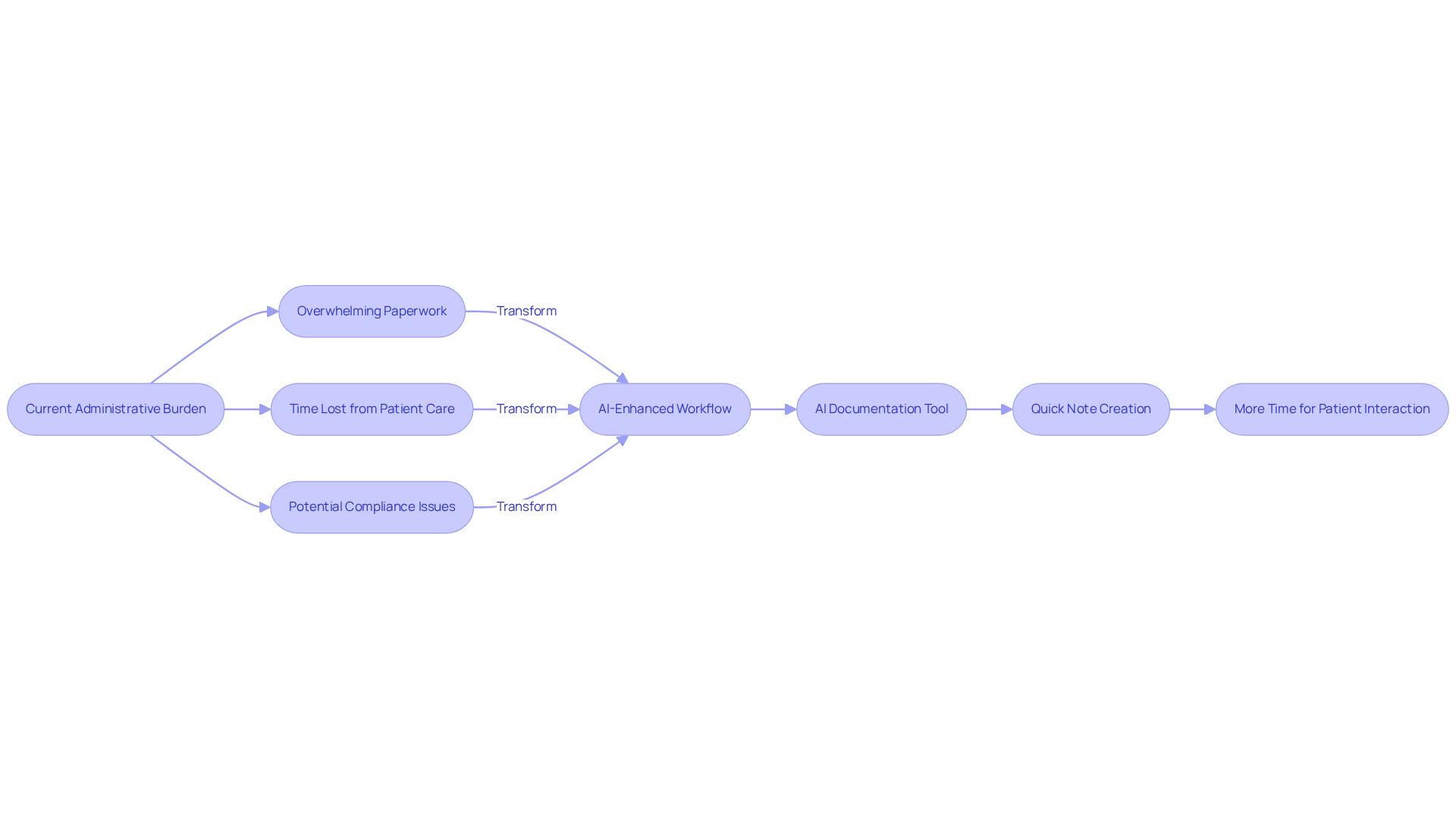
Headway: Efficient Progress Notes Feature for BIRP Documentation
In the demanding world of healthcare, providers often face overwhelming administrative burdens that can detract from their primary focus—patient care. Headway understands these challenges and offers a streamlined interface that significantly eases the process of composing the birp notes cheat sheet. With its , clinicians can swiftly document client interactions, ensuring that all essential information is captured without adding to their workload.
This increased efficiency not only saves valuable time but also enhances the quality of care for individuals. By alleviating administrative pressures, healthcare professionals can devote more attention to their clinical duties, fostering a nurturing environment for their patients. Imagine being able to spend more time with those who need your expertise the most.
Moreover, Headway harnesses the power of generative AI to automate various record-keeping processes, further reducing the administrative burden on physicians. This allows them to focus on what truly matters—providing compassionate care to their patients. As Dr. Kristine Lee points out, AI tools can efficiently sift through discussions to generate accurate clinical records, showcasing the technology's potential to improve documentation.
It's heartening to note that nearly two-thirds of surveyed doctors recognize the benefits of utilizing AI in healthcare. This acknowledgment underscores the importance of digital record-keeping tools like the birp notes cheat sheet and Headway, which not only streamline processes but also empower healthcare providers to deliver better care. By embracing these innovative solutions, we can collectively enhance the healthcare experience for both providers and patients alike.
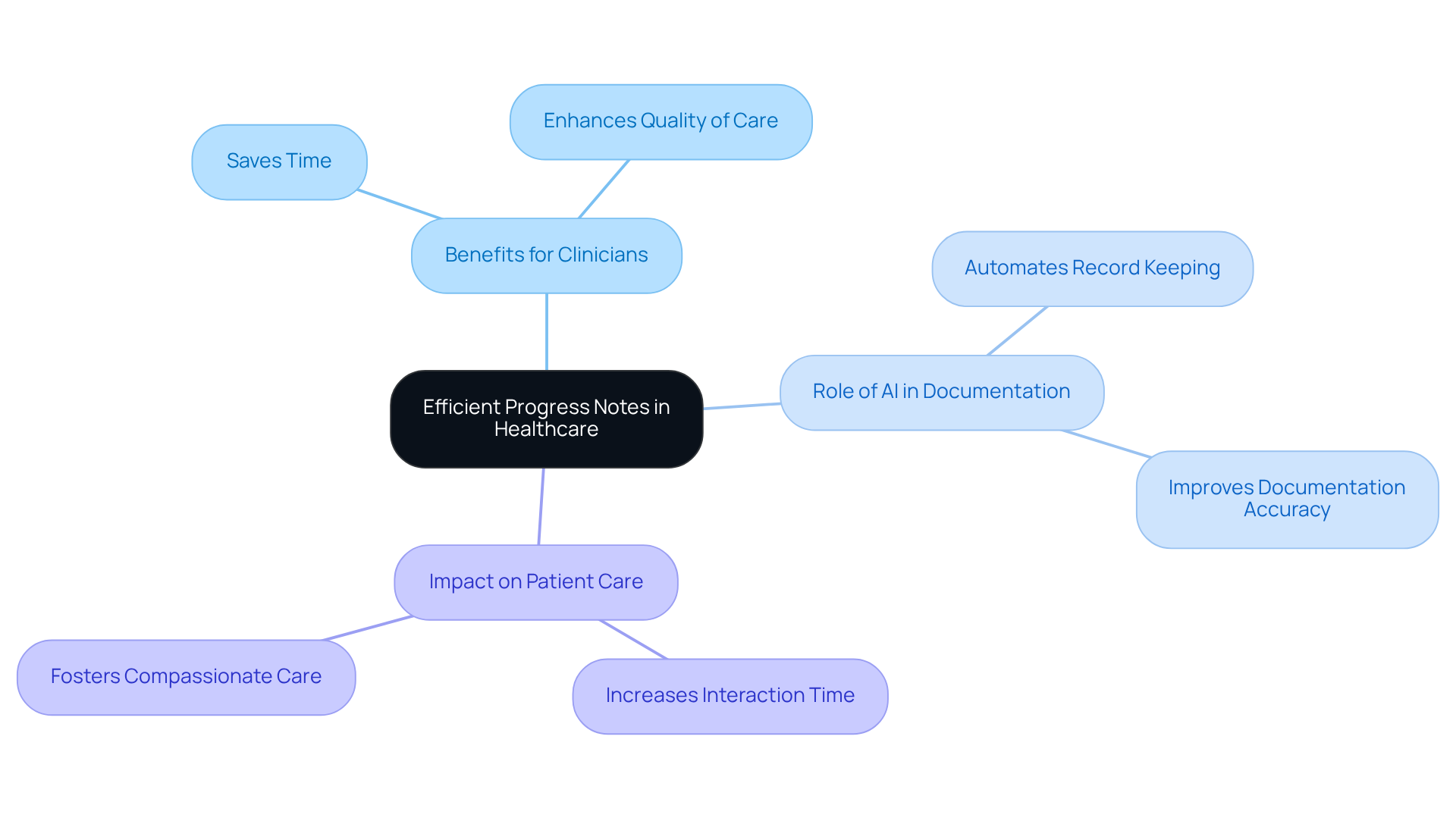
Luminello: Comprehensive Guide to Writing BIRP Notes
Luminello provides a compassionate guide that addresses the essential components found in the birp notes cheat sheet: Behavior, Intervention, Response, and Plan. Each section is thoughtfully explained, offering clinicians clear examples and best practices for effective documentation. This resource is invaluable for both novice and seasoned practitioners who wish to enhance their birp notes cheat sheet and note-taking skills.
Have you ever felt overwhelmed by the administrative burdens that can impact patient care? By focusing on visible actions in the Behavior section, clinicians can create a clear snapshot of client progress, which is vital for tracking improvements from session to session. The Intervention section elaborates on specific methods used during sessions, such as cognitive restructuring or relaxation techniques. Meanwhile, the Response section captures client reactions, highlighting their engagement and emotional shifts.
Ultimately, the Plan section outlines , ensuring that all records align with the individual's identified needs and comply with regulatory standards. This organized approach not only fosters collaboration among healthcare professionals but also supports regulatory adherence and improves outcomes for individuals. It also emphasizes the importance of including the individual's perspective in the record-keeping process.
Are you ready to refine your documentation skills and enhance your practice? This guide is here to support you on that journey.
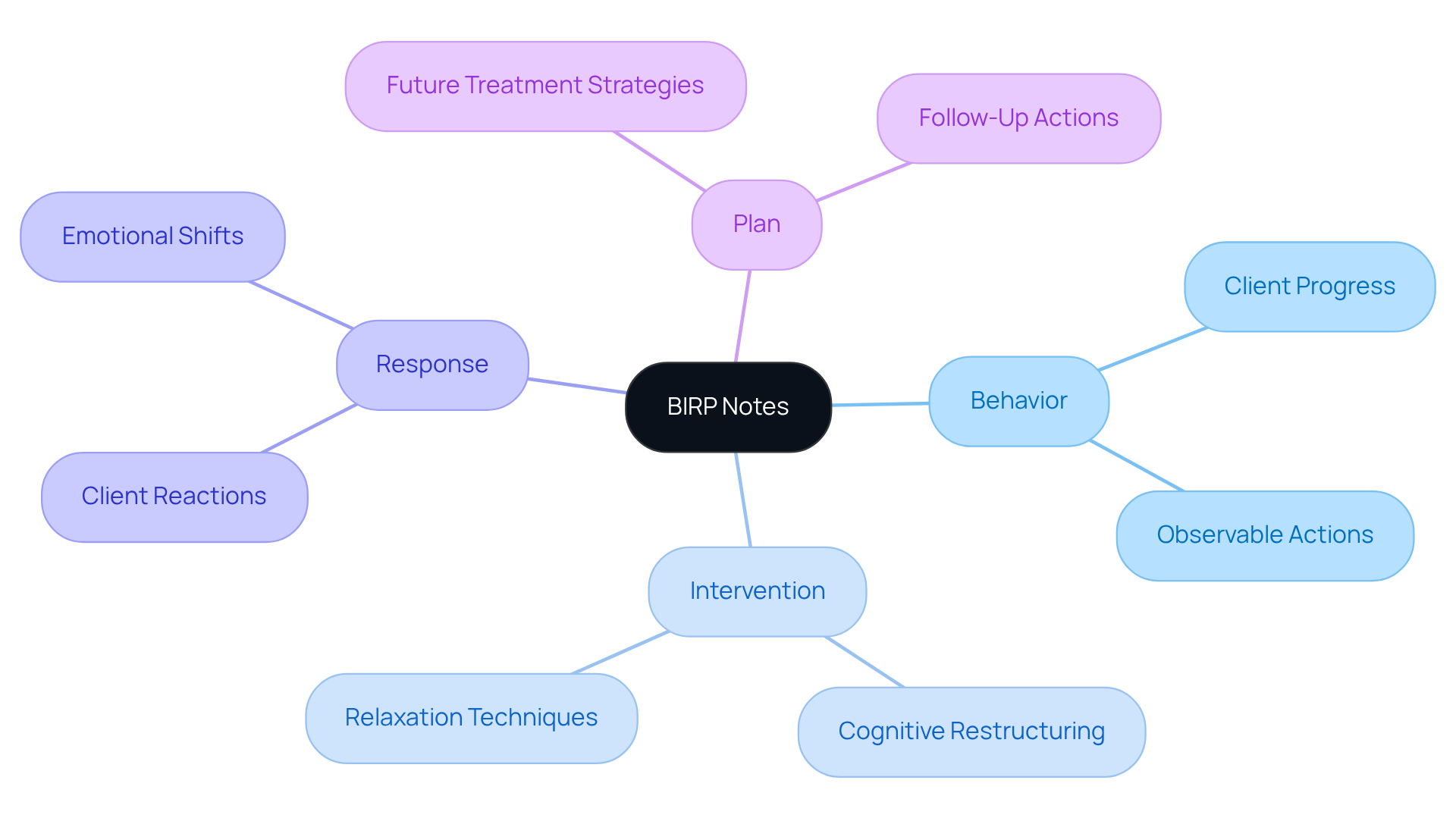
Mentalyc: BIRP Note Templates and Examples for Consistent Documentation
Mentalyc understands the emotional challenges faced by clinicians who strive to maintain consistent records amidst their demanding schedules. The wide array of templates and examples in the BIRP notes cheat sheet are not just tools; they are essential resources that guide providers in capturing critical information in a structured and organized manner. By utilizing these templates, clinicians can significantly enhance their efficiency and precision when recording interactions with individuals, ultimately leading to improved care outcomes.
Regular record-keeping is vital, as it promotes better communication among healthcare professionals and ensures that medical records are trustworthy and thorough. This is crucial for effective treatment planning and continuity of care. As Dr. October Boyles insightfully notes, "Creating behavioral incident reports is an essential aspect of providing efficient, responsible behavioral health services—but it can also be one of the most time-intensive activities in your day." With 74% of providers citing burnout due to increased hours worked with EHRs, it’s clear that Mentalyc's templates can help .
Moreover, incorporating generative AI tools into the record-keeping process—such as automated note-taking and data entry systems—can further enhance workflows, allowing clinicians to focus more on what truly matters: patient care. Healthcare professionals are encouraged to explore the birp notes cheat sheet to simplify their record-keeping process, ensuring they effectively capture the key components of Behavior, Intervention, Response, and Plan.
Consider how much easier your day could be with the right resources at your fingertips. Mentalyc is here to support you in your journey towards more efficient and compassionate care.
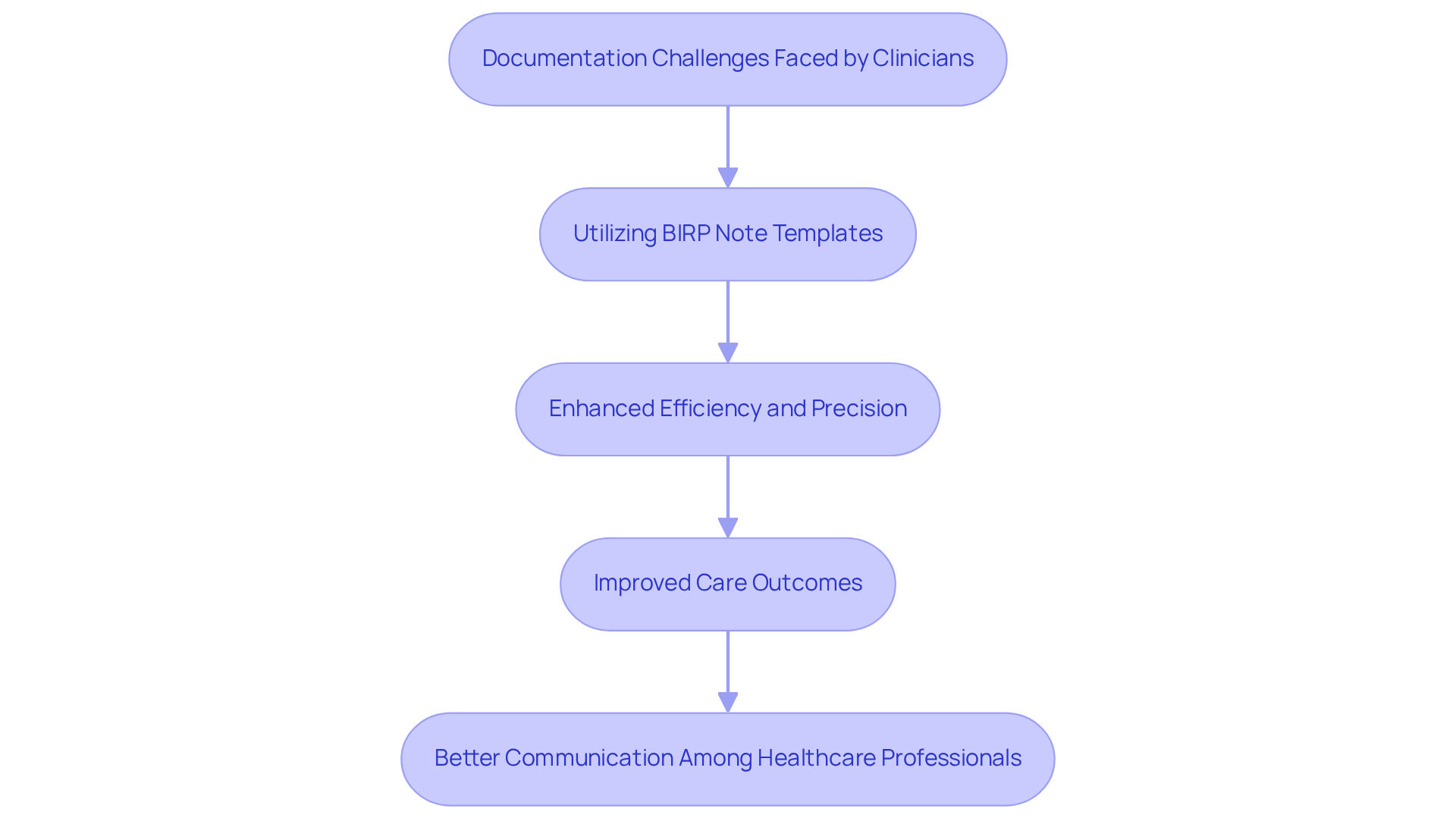
SimplePractice: Resources for Effective BIRP Note Writing
At SimplePractice, we understand the emotional challenges that clinicians face in their daily documentation tasks. The burden of administrative work can often overshadow the primary focus of patient care. That's why we offer a wide array of resources, such as the birp notes cheat sheet, designed to support you in enhancing your BIRP writing skills. From comprehensive guides to example records and practical advice, our birp notes cheat sheet clarifies the complexities of efficient documentation.
By utilizing these resources, you not only ensure compliance with healthcare regulations but also elevate the quality of care reflected in your records. In a fragmented healthcare system, where care is frequently divided among various providers, clear treatment records are crucial. They communicate client progress and care plans among clinicians, which is essential for maintaining continuity of care.
Moreover, healthcare organizations that embrace organized record-keeping practices have reported remarkable improvements in compliance metrics, including a 63% reduction in compliance-related incidents. Imagine the peace of mind that comes from knowing your documentation processes are optimized, allowing you to dedicate more time to what truly matters—your patients.
Prompt revisions to documentation are vital for ensuring that clients receive uninterrupted care, especially when transitioning between providers or consulting multiple specialists. These revisions foster effective communication in our often disjointed healthcare systems. As Dr. October Boyles aptly notes, 'The standard structure for behavioral intervention reports enables mental health practitioners to compose high-quality records at an efficient pace.'
We invite you to explore the resources offered by SimplePractice and discover how they can , ultimately enhancing your ability to provide compassionate care.

BehaveHealth: Best Practices for Writing Effective BIRP Notes
At BehaveHealth, we understand the emotional challenges that healthcare providers face, especially when it comes to documentation. The importance of specificity and objectivity in creating an effective birp notes cheat sheet cannot be overstated. Clinicians are encouraged to explicitly link each intervention to the client's treatment goals, as this connection can significantly influence treatment outcomes. For example, when documenting a cognitive restructuring intervention, it is essential to specify how this approach addresses the client's identified issues, such as anxiety or depression. This clarity not only strengthens the rationale behind the intervention but also aids in tracking progress over time.
Maintaining a consistent format is equally vital for fostering understanding. A structured approach enhances clarity, making it easier for both the clinician and other healthcare providers to follow the client's journey. Regularly revisiting notes for clarity and coherence can elevate the quality of records, ensuring that essential details are not overlooked. As specialists remind us, 'If you didn’t record it, it didn’t occur.' This underscores the crucial role of comprehensive records in effective therapy.
Including specific instances of effective records can also serve as a valuable guide. For instance, a well-documented response might illustrate a client's emotional shift after a mindfulness exercise, linking it back to the therapeutic goal of reducing anxiety. By adhering to these best practices, clinicians can enhance the quality of their records using a birp notes cheat sheet, ultimately benefiting patient care and nurturing a more effective therapeutic relationship.
Furthermore, completing session summaries promptly after each meeting is essential for precision and progress monitoring. This practice guarantees that all pertinent details are recorded in a timely manner. These records are adaptable for use in various settings, such as mental health facilities, hospitals, and private practices, further highlighting their significance in clinical documentation. Together, let us strive to improve our for the betterment of our clients.
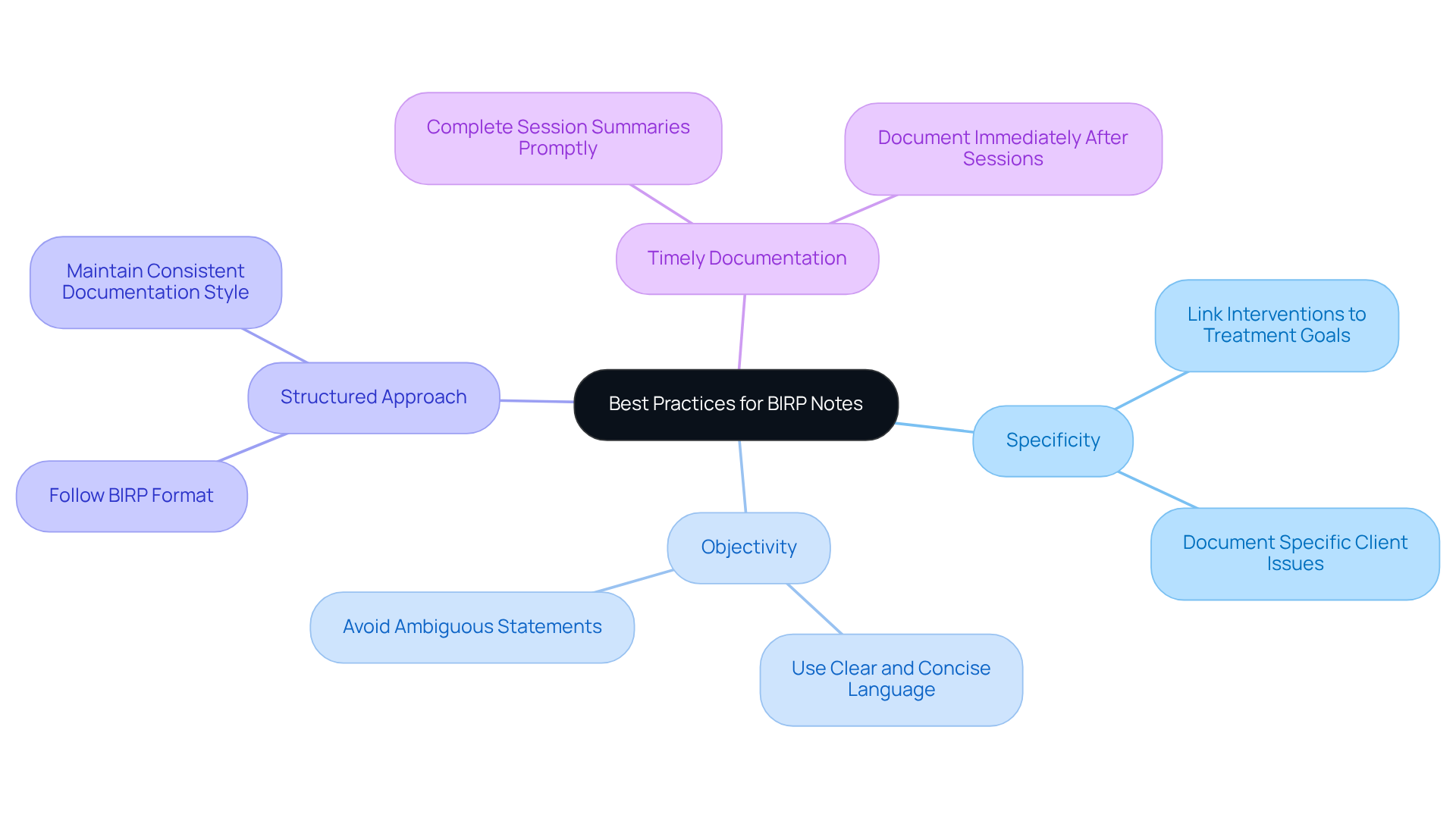
Physio-pedia: Understanding the Structure and Benefits of BIRP Notes
In the demanding world of healthcare, providers often face emotional challenges, particularly when it comes to documentation. Physio-pedia offers a birp notes cheat sheet that outlines a framework for therapeutic documentation, which includes four essential elements:
- Behavior
- Intervention
- Response
- Plan
Each section is designed with a distinct purpose, allowing clinicians to comprehensively document their interactions with patients.
Utilizing can alleviate some of the administrative burdens that impact patient care. By embracing this approach, providers can experience greater clarity in their records, which fosters improved communication among caregivers. Moreover, this method enhances the monitoring of individual progress, ultimately leading to better patient outcomes.
Imagine the ease of having a clear, organized record that not only reflects your hard work but also supports your patients' journey to recovery. By utilizing the birp notes cheat sheet framework, you can make a significant difference in your practice and the lives of those you serve. Let’s embrace these tools together and enhance the care we provide.
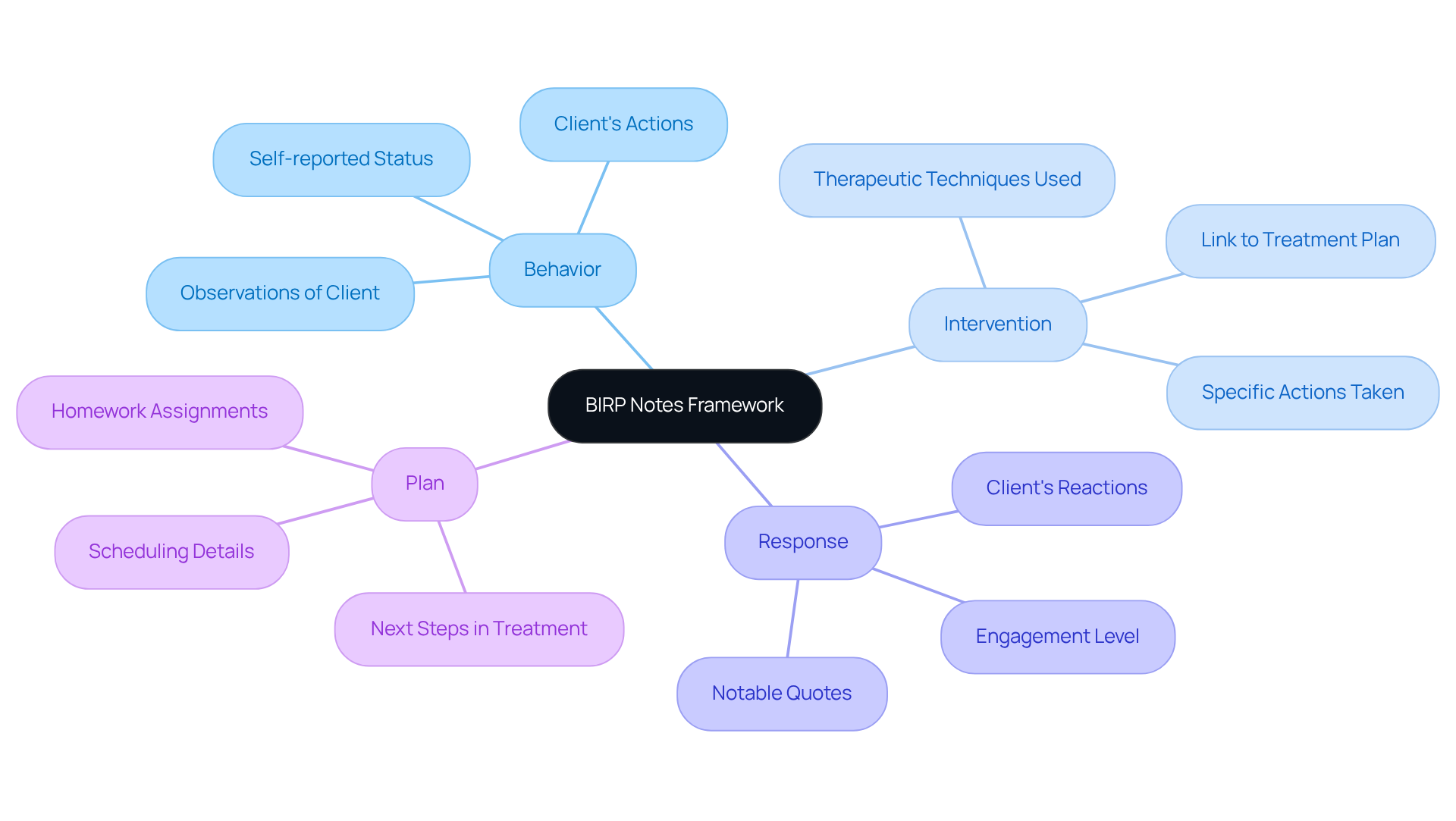
Headway: Essential Requirements for BIRP Notes in Clinical Documentation
In the demanding field of healthcare, providers often face emotional challenges that can feel overwhelming. Headway outlines the essential requirements for BIRP documentation, which can be summarized in a birp notes cheat sheet, emphasizing the necessity of clear and concise language, objective observations, and direct connections to treatment goals. These records are not just about meeting regulatory requirements; they play a crucial role in improving care for individuals.
Clear language is vital. It reduces misunderstandings and ensures that all healthcare providers involved in an individual's care can easily interpret the notes. Have you ever experienced confusion due to vague documentation? Objective observations should be prioritized, as they provide a factual basis for treatment decisions and facilitate better communication among providers. By connecting observations directly to treatment objectives, we strengthen the intent of our records, ensuring they serve as a valuable resource in the therapeutic process.
By following these standards, clinicians can create records using the birp notes cheat sheet that are both compliant and impactful. This ultimately supports for individuals, fostering a nurturing environment where every patient receives the care they deserve. Let's work together to create documentation that truly reflects our commitment to compassionate care.
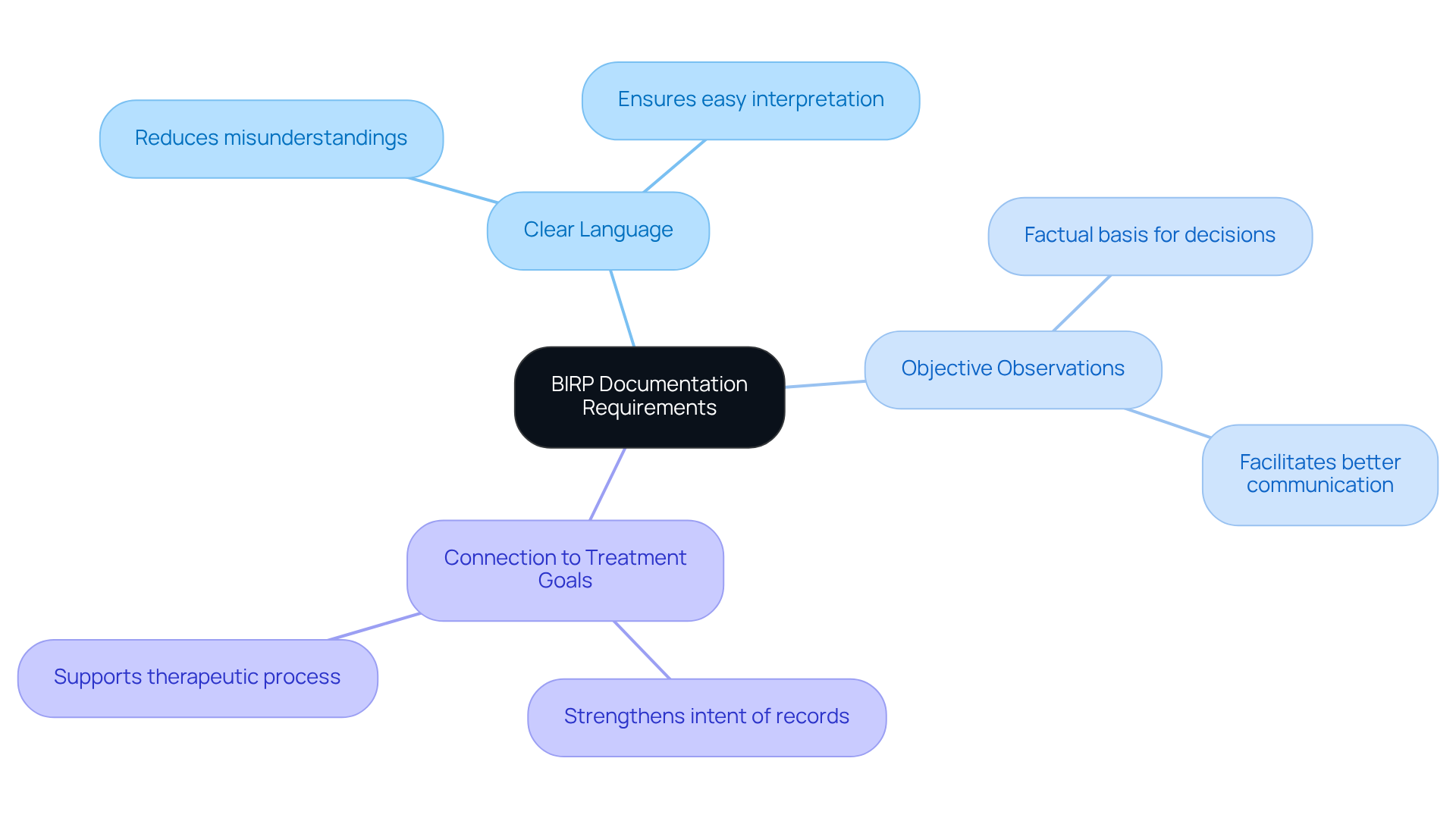
BehaveHealth: Common Mistakes to Avoid in BIRP Note Writing
In the demanding world of healthcare, BehaveHealth recognizes the emotional challenges faced by providers when using the birp notes cheat sheet to create BIRP records. These records are vital, yet several critical errors can significantly impact patient care results. Common pitfalls, such as vague language, can obscure the clarity of a client's progress and treatment effectiveness. Have you ever felt that your notes didn’t fully capture the nuances of patient care? Failing to link interventions directly to treatment objectives can lead to misalignment in care strategies. Additionally, neglecting to review notes for clarity may result in record-keeping errors that compromise the therapeutic process.
Consider this: record-keeping errors have been shown to double the likelihood of a case concluding with an indemnity payment. This statistic highlights the legal consequences of maintaining accurate records. By recognizing these issues, clinicians can enhance the quality of their documentation, creating a birp notes cheat sheet that serves as a robust tool for supporting patient care. High-quality progress records not only support continuity of care but also contribute significantly to legal accountability.
So, how can we improve? Here are a few key solutions to consider:
- Use clear and precise language in documentation.
- Regularly link interventions to specific treatment objectives.
- Review notes diligently to ensure clarity and accuracy.
Ultimately, ensuring is crucial for effective clinical practice. By addressing these common challenges, we can foster a more supportive environment for both providers and patients alike.
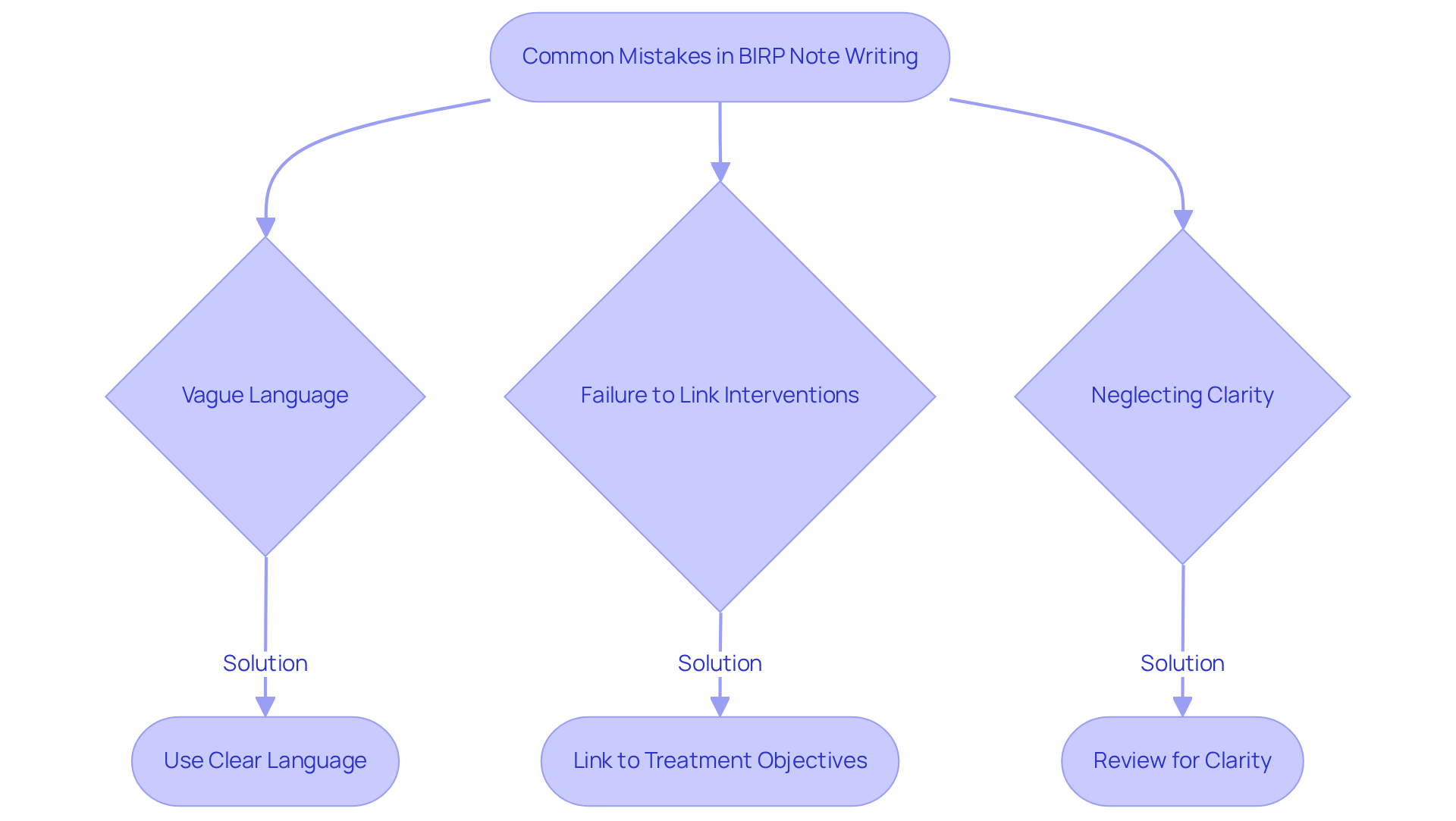
SimplePractice: Importance of Patient-Centered Observations in BIRP Notes
SimplePractice highlights the vital importance of patient-centered observations as outlined in the birp notes cheat sheet. Clinicians are encouraged to document not only observable behaviors but also the individual's self-reported experiences and emotional states. This holistic approach to documentation enhances the quality of care and strengthens the patient-provider relationship. By capturing a comprehensive view of the individual's condition, providers can tailor interventions more effectively, fostering a collaborative environment that enhances trust and communication.
The birp notes cheat sheet includes the BIRP note format, which consists of four components: Behavior, Intervention, Response, and Plan. Each serves a specific purpose in documenting therapy. For instance, incorporating an individual's emotional feedback alongside behavioral observations can provide greater insight into their progress and challenges. This ultimately leads to more . Such an approach aligns with the growing recognition of the significance of empathy and understanding in healthcare, reinforcing the idea that effective record-keeping is not just about compliance but about genuinely connecting with individuals and addressing their needs.
As Innocent Turner, a Clinical Strategy and Quality Manager, notes, "When someone reads a note, they need to comprehend how your client presented, what's happening with them currently, how you assisted them, and how they perceived that support." Additionally, leveraging AI-driven automation can simplify the documentation process, allowing clinicians to focus more on patient care while ensuring compliance with documentation standards.
In this way, we can alleviate some of the administrative burdens that often weigh heavily on healthcare providers. By embracing these practices, we not only enhance our documentation but also enrich the care we provide. How can we better support each other in this journey? Let's continue to explore ways to improve our connection with patients and each other.
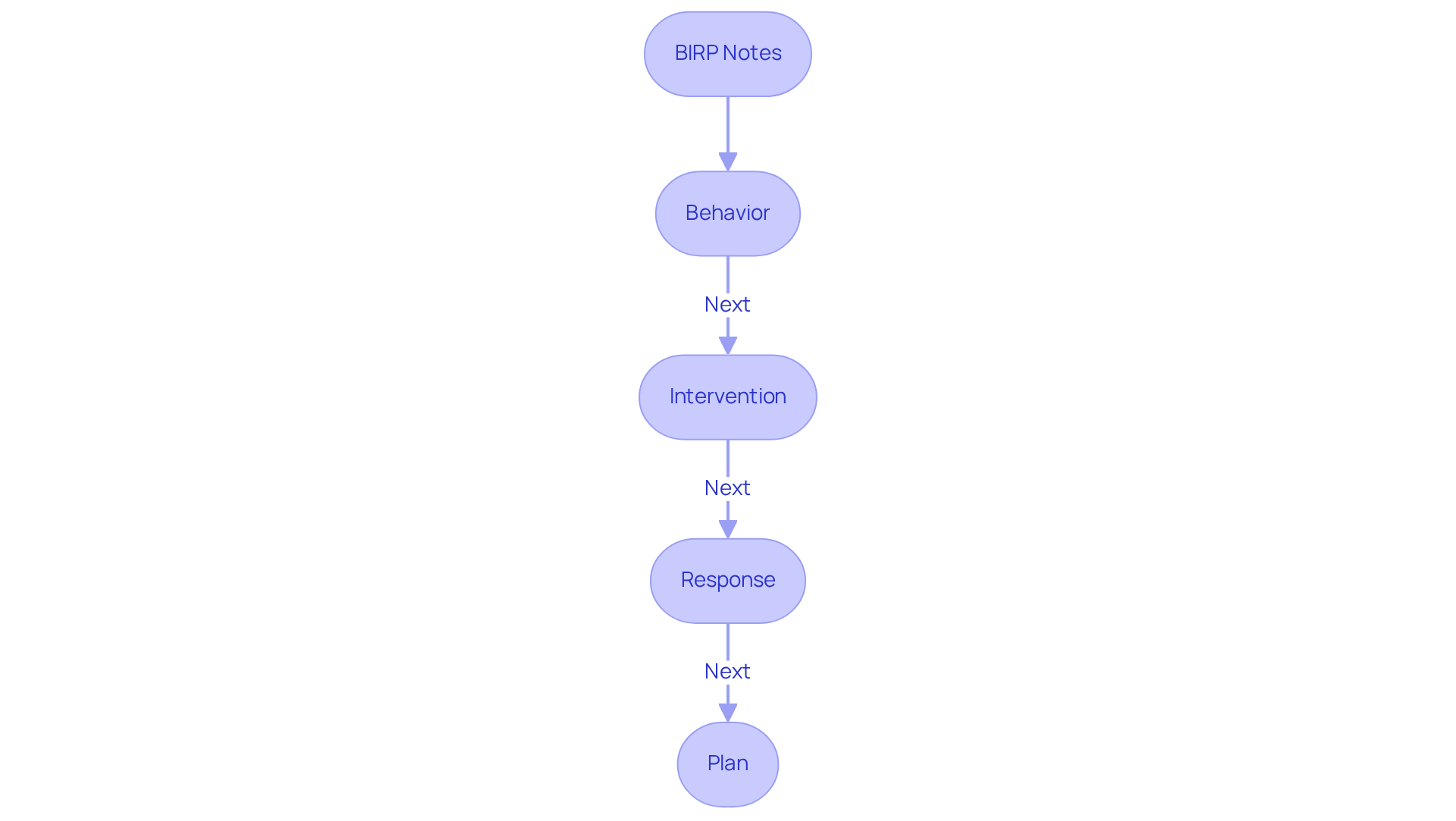
Conclusion
Utilizing a BIRP notes cheat sheet can significantly enhance the efficiency and effectiveness of clinical documentation. Have you ever felt overwhelmed by administrative tasks, taking time away from patient care? By streamlining the recording process, healthcare providers can focus more on delivering high-quality patient care rather than getting bogged down by paperwork. The integration of advanced tools and resources, such as AI technology and structured templates, empowers clinicians to create precise and compliant notes that reflect their professional interactions with patients.
Throughout the article, we shared key insights regarding various tools and practices that can aid in the effective use of BIRP notes. Consider the following resources:
- CosmaNeura's AI solutions that reduce administrative burdens
- Luminello's comprehensive guides
- Mentalyc's templates
These resources not only promote consistency in documentation but also enhance communication among healthcare providers. Moreover, the emphasis on patient-centered observations and the avoidance of common pitfalls highlights the importance of clarity and specificity in therapeutic documentation.
As the healthcare landscape continues to evolve, embracing these innovative documentation practices is crucial. By prioritizing efficient record-keeping, clinicians can foster a more compassionate and attentive care environment. Imagine the positive impact on patient outcomes when documentation serves as a powerful tool for both care delivery and professional accountability. It is imperative for healthcare providers to explore these resources and integrate them into their daily practices, ensuring that documentation supports their mission to provide empathetic and effective care.




